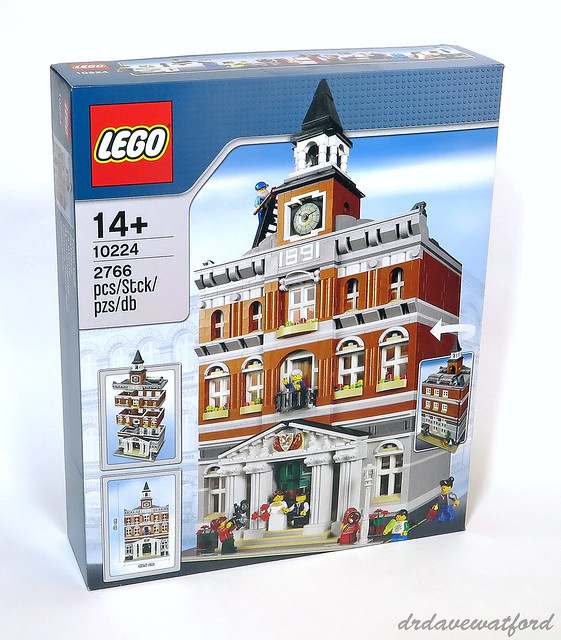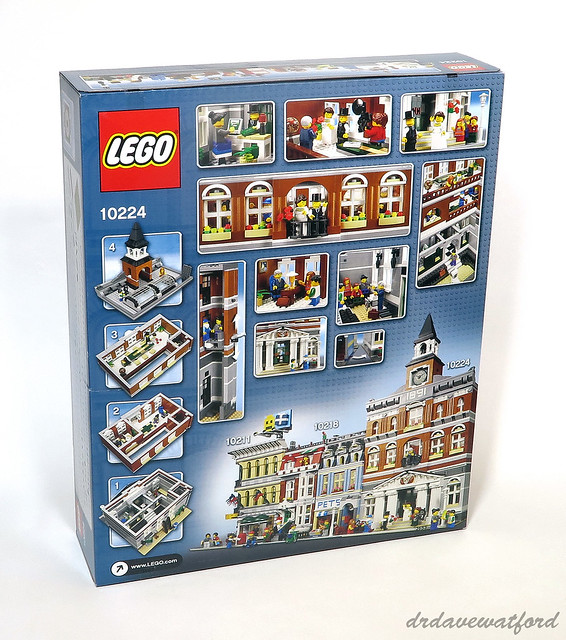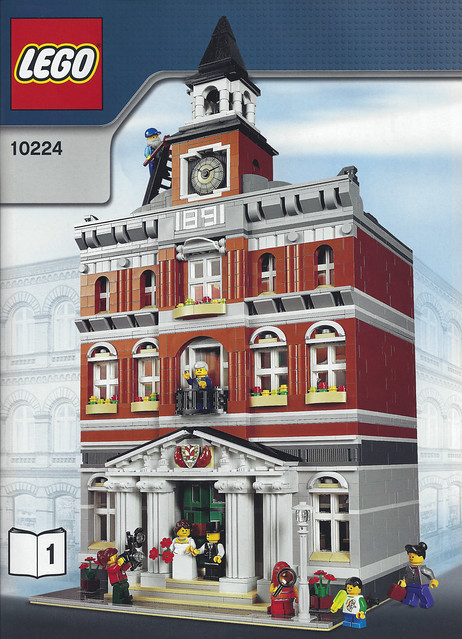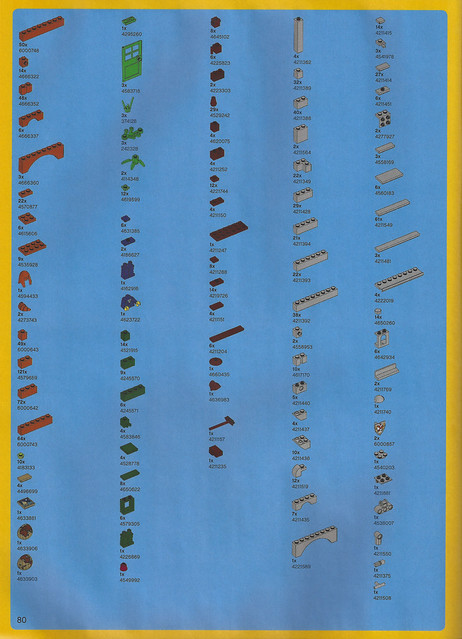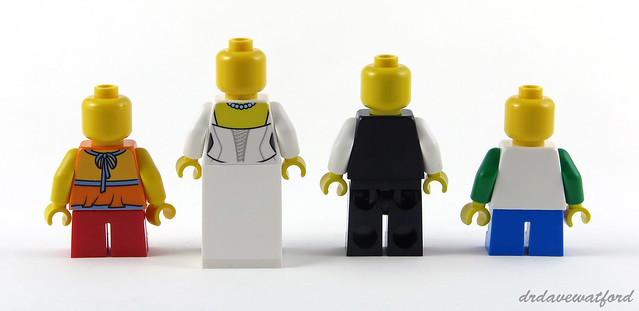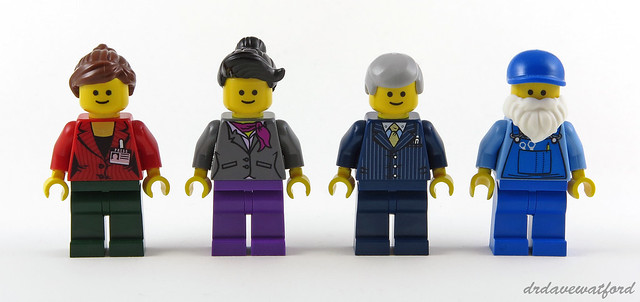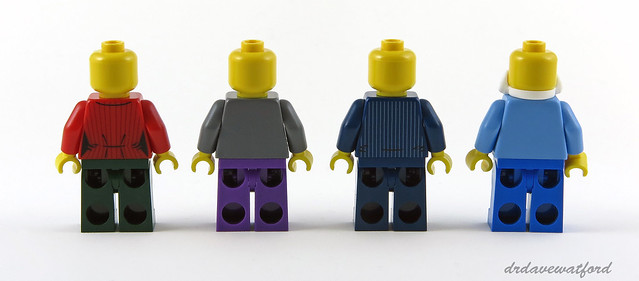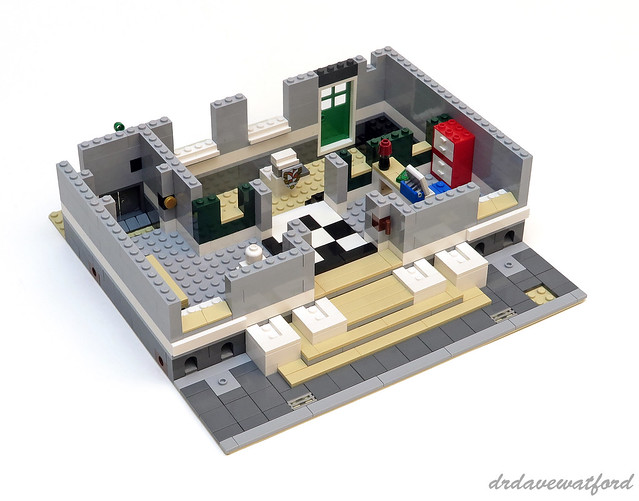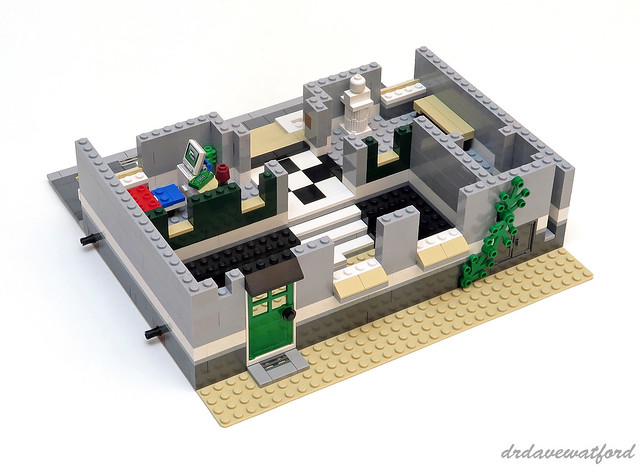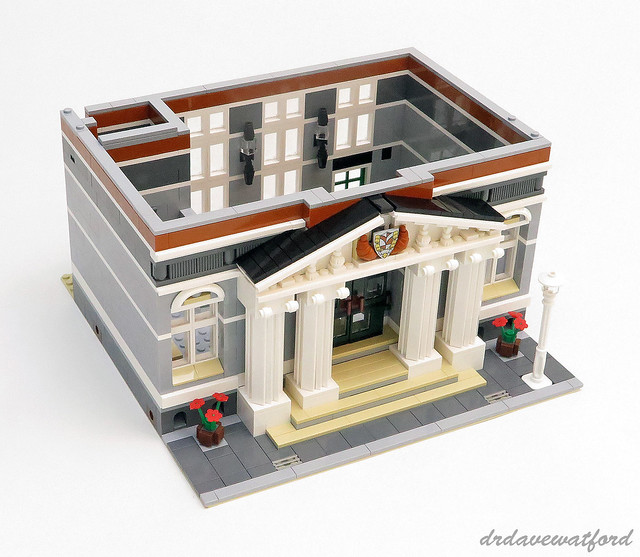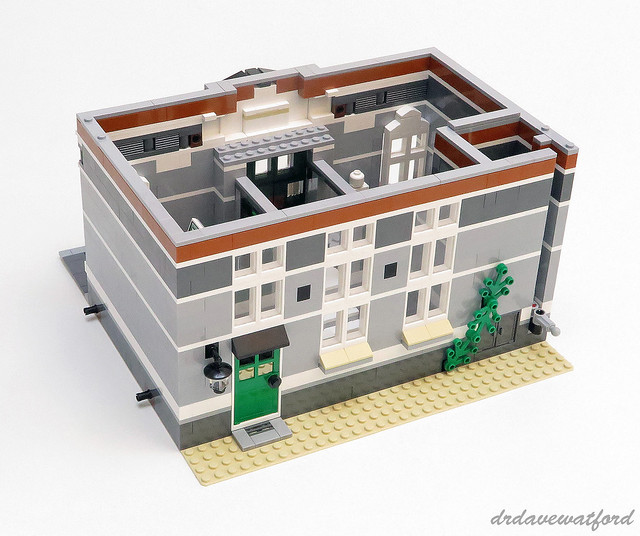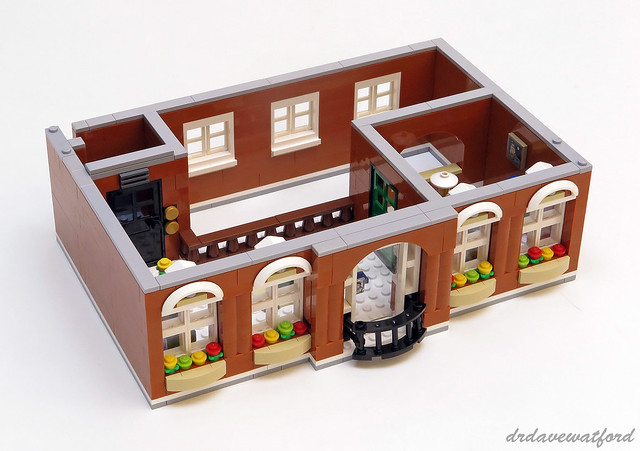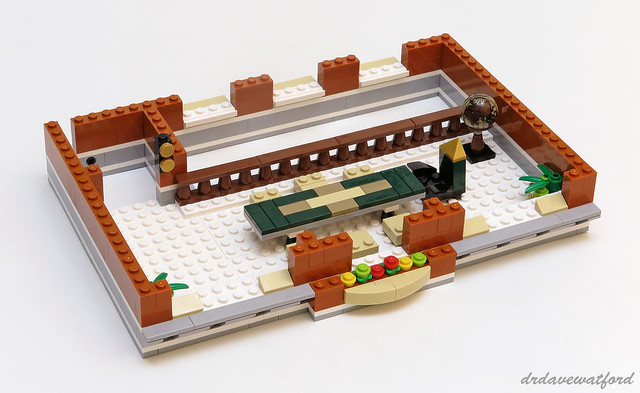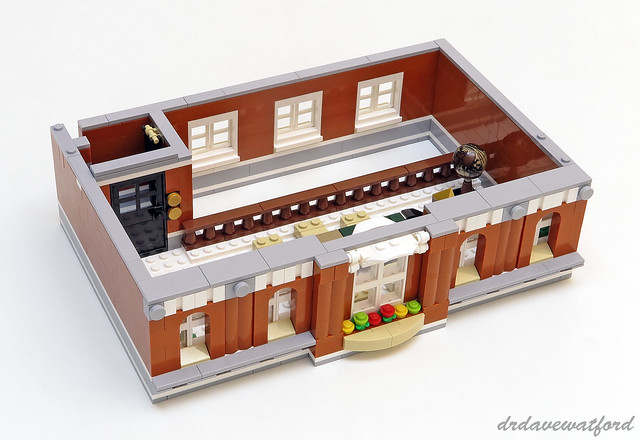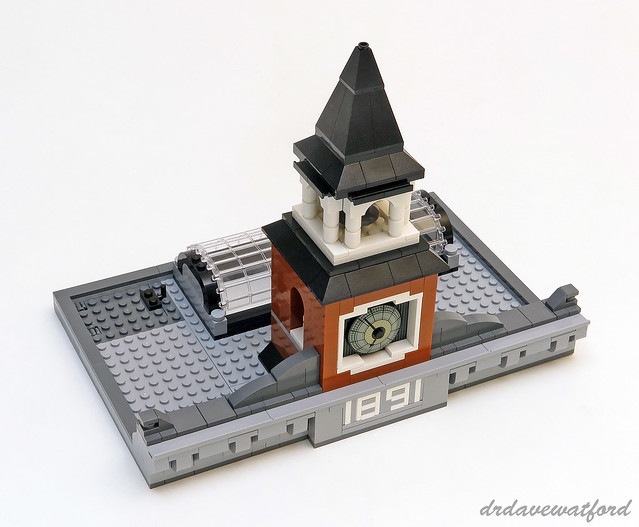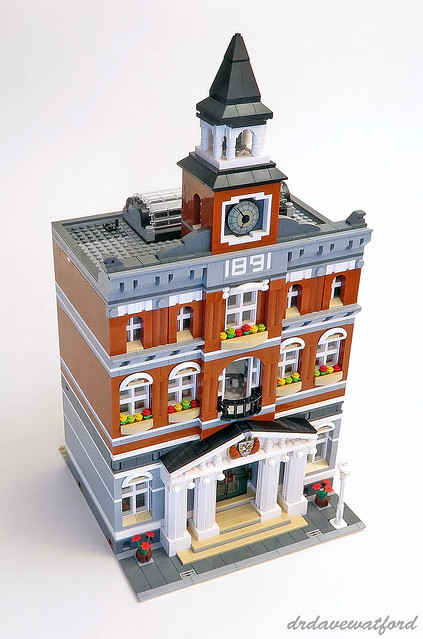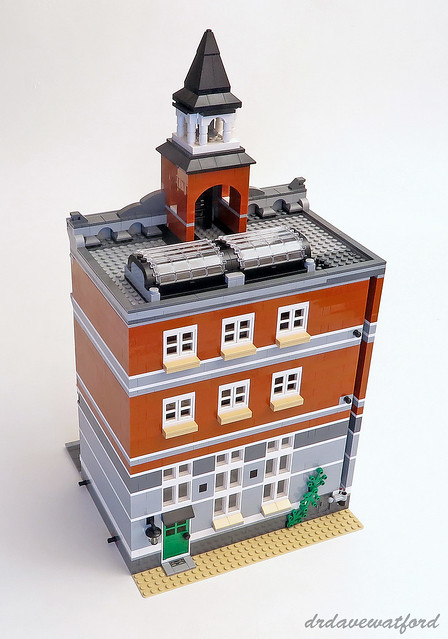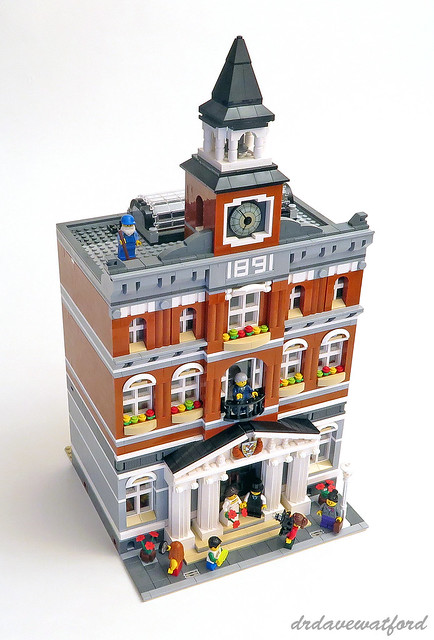Having built and reviewed the wonderful Set 10243 Parisian Restaurant a few weeks back (you can check out the review here if you missed it) my quest to get caught up on the Modular Buildings was off to a good start and I was keen to take on another one. Set 10224 Town Hall, released in 2012, was next on my list.
The front of the box (above) lacks the Creator Expert branding carried by the more recent Modular Buildings. Unusually, the box needs to be stood on end in order to view the box art in the correct orientation, and I think this is the only Modular for which that's the case. An image of the completed build occupies the full height of the box, and in addition to the main image the front of the box also features a trio of inset panels showing an exploded view of the Town Hall's four distinct sections, the dimensions of the completed model, and a rear view of the build. The back of the box (below) features a number of wedding-related vignettes set in and around the building as well as once again highlighting the model's four sections and showcasing a few of the set's play features. There's also a picture of the Town Hall displayed alongside a couple of older Modular Buildings, specifically 10211 Grand Emporium and 10218 Pet Shop.
The contents of the box are accessed by cutting a couple of tape seals. Inside the box are three instruction booklets which are sealed inside a cardboard-backed transparent bag. There are also 30 sealed bags of LEGO elements in total, all but one of which is printed with a '1', a '2' or a '3' corresponding to the stage of the build that the elements within are needed for. Finally, there's a tan 32 x 32 baseplate loose within the box; this has appeared in a total of 8 sets including this one. The set doesn't include a sticker sheet.
The three instruction booklets have identical covers (above) apart from the booklet number printed in the bottom left corner. The first booklet has 76 pages and consists exclusively of building instructions apart from the back cover which, like the back of the box, advertises the three Modular Buildings available at the time of the Town Hall's release; only the Pet Shop is still available at retail as I write this, and I suspect it won't be around for much longer. The second instruction booklet is much slimmer than the others at only 40 pages; in addition to building instructions it contains advertising for Set 10222 Winter Village Post Office, Set 10220 Volkswagen T1 Camper Van and a couple of the 2011 Creator offerings. At 84 pages, the third booklet is the lengthiest of the three and in addition to buiding instructions it contains a 4-page inventory of elements (sample page below - click to enlarge) and advertising for the LEGO Club, the VIP Programme and an obligatory product survey.
The set contains a total of eight minifigures. All of them are surprisingly unique to the set, although most of their constituent elements have appeared as a part of other minifigures. All eight minifigures have a classic yellow smiley head print and standard, unprinted legs. The Bride (below) has an attractive wedding dress torso print which extends to the back of her torso and is exclusive to this minifigure, although her long dark brown braided hair can be readily found elsewhere as can her 'legs' which consist of an unprinted white 65 degree 2 x 2 x 2 slope representing her long skirt. The Groom has a torso print featuring a waistcoat and tie. This torso has thus far appeared as a part of 19 different minifigures and in no less than five Modular Buildings to date, most recently 10243 Parisian Restaurant. The imaginatively-named Girl has fetching long dark orange hair which has only previously been available in this colour as a part of four minifigures including a couple of Ginny Weasley variants from the Harry Potter theme. Her orange torso, with its cute back-printed halter top pattern, has appeared as a part of 11 minifigures to date. Despite being exclusive to the set the Boy is made up of commonly-available parts, with the exception of his white torso printed with a Classic Space floating minifigure design; I was surprised to discover that this torso has only appeared in 13 minifigures to date as I seem to have seen it a number of times recently.
You can see the Bride, Groom, Girl and Boy from behind in the picture below with their hair and hats removed. Only the Bride and the Girl have back-printed torsos, and none of the minifigures have alternate expressions.
The other four minifigures in the set can be seen in the picture below. The Secretary has a nice torso print featuring a dark bluish grey suit jacket, pink shirt and magenta scarf; her unprinted dark purple legs nicely complement the pink and magenta of her torso. Her black hair, which is styled with a top knot bun and a forelock, has only made an appearance in five minifigures including this one. The Mayor is dressed in dark blue. His torso, which is printed with a pinstriped jacket and gold tie pattern, has only been included in a total of eight minifigures to date. He's otherwise made up of elements which have appeared on many other occasions, which is also the case for the Janitor, whose face is all but obscured by his bushy white beard and blue baseball cap. His torso print features blue overalls with a couple of tools peeking out of the central pocket. Finally we have the Photographer. For some reason the normally-reliable Bricklink doesn't appear to acknowledge her existence within the set, but thankfully Brick Owl isn't so cavalier. Her torso print, which consists of a red low-cut pin-striped jacket and a press pass, has been restricted to just a handful of minifigures, most recently making an appearance in promotional set 40221 Fountain.
As you can see from the picture below, only the Mayor and the Photograher have backprinted torsos. Once again none of the minifigures have an alternate expression.
A total of 14 of the sealed bags of elements are required for Stage 1 of the build, instructions for which are found in the first instruction booklet. In time-honoured Modular fashion, the build commences with some tiling, in this case construction of a narrow, tiled pavement/sidewalk area along one edge of the baseplate. The pavement incorporates an obligatory pair of metallic silver modified 1 x 2 tiles with grille representing drains which have been a part of every Modular build that I've ever attempted. Next the floor plan of the Town Hall is mapped out, predominantly with dark bley and black bricks, and a staircase leading up from the pavement to the front entrance is constructed and topped off with tan tiles. As usual, four 1 x 2 Technic bricks are strategically positioned at ground level at the sides of the baseplate to enable the Town Hall to be attached to other Modular Buidings via a couple of Technic pins, and dark bluish grey 1 x 3 arches, which provide some detailing at the base of the front of the building, are dropped into place; these have only ever appeared in 7 sets including this one. A false floor is constructed at the level of the top of the staircase, although a couple of areas towards the rear of the ground floor remain at baseplate level; a podium complete with a lectern is placed in the larger of these two areas, which will become an auditorium. The lectern is embellished with a printed shield which is unique to the set. The smaller of the two areas is the bottom of a lift/elevator shaft. This will later accommodate a simple manually operated lift.
Just inside the front entrance there's a plinth formed from a couple of round 2 x 2 bricks with grille. On top of this is a white, unprinted minifigure head on a jumper plate; it's not entirely clear what this is, but I'm guessing it's supposed to be a marble bust. A tan table is placed against the wall nearby, while a smaller table bearing a lamp with a dark red fez lampshade, a hundred dollar bill and a desktop computer with printed tiles representing the screen and keyboard is assembled and positioned in what will become a small office on the other side of the ground floor. Meanwhile, the outer walls are built up with layers of dark bluish grey, white and light bluish grey bricks, and a few dark green bricks make an appearance in some of the internal walls. Round the back a door is installed, while green foliage creeps up the back wall of the building and a lamp which incorporates a trans-clear 1 x 1 brick is hung next to the back door.
Windows are then installed front and back, with white mud guards providing detailing over the windows at the front, after which a substantial, brick-built front door is constructed. The front door incorporates a number of dark green 1 x 2 x 2 windows which have only ever appeared in three sets in this colour. The doors attach to a brick-built door frame by way of dark green modified 1 x 1 bricks with clip which are similarly uncommon in this colour. The four columns at the front of the building are next to be assembled. Each one has a core of SNOT bricks including reddish brown modified 1 x 1 bricks with studs on two sides which have appeared in seven sets including this one; modified 1 x 8 plates with door rail cover the central core, and white 1 x 8 tiles provide a tidy, studless appearance. The top, or capital, of each column incorporates a modified 1 x 1 plate with clip light which confers a scroll-like appearance not dissiminar to the volutes found at the head of Ionic columns. The columns form part of a portico; the roof, or pediment, of the portico, has a triangular area below it called a tympanum which is typically carved and decorated in real life. In the case of the Town Hall it has a central feature consisting of the same shield which we were introduced to earlier flanked by a couple of dark orange croissants, with a pair of white skeleton legs on either side of it; it sounds faintly ridiculous, but it actually looks pretty good!
The outer walls continue to be built up, predominantly with layers of light and dark bluish grey bricks. This culminates in the placement of a layer of dark orange bricks which is topped off with light bluish grey tiles. A lamp post and a couple of flower pots are then installed on the pavement outside the front of the building, at which point the ground floor is finished. All that's left to do is to build a camera complete with long lens and flash for the press photographer, at which point Stage 1 of the build is complete.
Only five sealed bags of elements are needed for Stage 2 of the build which comprises the second floor of the Town Hall. Some of the plates contained in the unmarked bag are also required, including a couple of white 6 x 24 plates which make up a large part of the floor area and which have only ever appeared in six sets including this one. After building the floor it's time to start on the walls. Some of the dark orange bricks used in the construction of the walls have featured in relatively few sets to date, for instance just eight sets in the case of dark orange 1 x 3 and 1 x 8 bricks. An area of the floor centrally is covered with a small mosaic featuring tan, dark blue and dark green tiles, and a reddish brown ballustrade is constructed to fence off an open section towards the rear; when the second floor is eventually stacked on top of the ground floor this open section will be positioned directly above the auditorium on the ground floor so that proceedings can be observed from the higher floors of the building. Next some rudimentary furniture - a few chairs, plus a desk and a table compete with ornaments including a dark bluish grey frog - are built and put into place.
Four window boxes are then constructed at the front of the building on either side of a rather hazardous balcony with a glaring gap between the curved railings and the balcony floor, and stacks of dark orange modified 1 x 2 log bricks are used to fill the gaps between windows; while log bricks in this colour have appeared in a number of other sets, there are a total of 48 of them in this set which is significantly more than in all the other sets put together. The internal walls incorporate a dark orange 1 x 8 x 2 arch; this can be found in a total of just four sets. The elevator shaft continues upwards into the second floor where it's guarded by a black door, while a green door closes off a small office to the right; the walls of the office are furnished with some token decoration in the form of a printed 2 x 2 dark tan tile. A trans-clear door at the front provides balcony access. Similar to the ground floor, white vehicle mud guards provide some detailing over the four front windows, while a dark orange 1 x 8 x 2 arch frames the balcony door. Finally, the walls are topped off with light bluish grey tiles and the second floor is done.
The last stage of the build, which involves construction of the top floor of the Town Hall plus the roof and clock tower, requires the ten remaining sealed bags of elements plus the outstanding contents of the unmarked bag. The build commences with construction of an identical floor to that of the level below, featuring the same open area towards the rear to provide a view down to the auditorium. The top floor accommodates a conference room which is dominated by a large table with a dark green, tan and dark tan-tiled tabletop and six tan chairs. A reddish brown ballustrade forms the rear boundary of the conference room overlooking the auditorium, and there's an entrance to the lift which is closed off by a black door as was the case for the floors below. The interior of the second floor is sparsely furnished, with a 2-piece dark tan printed globe only previously available in 70810 Metalbeard's Sea Cow and 4191 The Captain's Cabin, providing the only decoration apart from the conference table and chairs. Some simple light bluish grey cornicing is added at the front of the second floor where it meets the floor below.
The rear wall is constructed in exactly the same way as was the case for the floor below, including the installation of three 1 x 4 x 3 windows with opening panes. The windows at the front are different from those installed in the floor below, however, featuring 1 x 2 x 2 windows arranged in a 2 x 2 pattern which are overlapped at their outer margins by the external walls and partially obscured at the top by 1 x 4 brick arches; it's an interesting idea, but in practice too much of the window area ends up being filled by the window frames in my opinion so I don't think it's entirely successful. The area above the central window is decorated by detailing which once again features white vehicle mud guards, albeit of a different variety to those used in the lower floors, and light bluish grey tiles once again sit atop the walls in preparation for the placement of the section above, namely the roof.
The roof section is dominated by a clock tower and an excellently-realised curved skylight made up of trans-clear garage roller door sections. In fact, clever building tricks abound during this stage of the build, not least the ingenious technique used in constructing the elegant cornicing at the front of the roof. Basically, modified 1 x 2 x 1 1/3 bricks with curved top are attached upside down to modified 3 x 2 plates with hole and then threaded through 1 x 2 x 2 castle windows - very neat. Another clever building trick on show is the use of a myriad of SNOT techniques to spell out the year '1891' at the base of the clock tower, a feature borrowed from 10197 Fire Brigade which uses similar techniques to incorporate '1932' into its roof section. The Town Hall clock tower includes a clock face printed on a black 4 x 4 inverted dish; this printed element has only ever appeared in one set apart from this one, namely 10245 Santa's Workshop. A bell sits within the roof space of the tower above the clock, although it's unfortunately dark bluish grey rather than pearl gold like the bell in the Fire Brigade set.
With the roof now complete it's time to stack the sections and check out the finished Town Hall. The completed build is pretty imposing, and at fully half a metre in height I suspect it's the tallest of all the Modular Buildings to date, and quite possibly the heaviest as well.
Having recently raved about the Parisian Restaurant, I'm afraid that I can't be as effusive about the Town Hall. I certainly enjoyed the build overall, and it incorporates some nice features such as the portico, the skylight and a lift which can be manually raised and lowered via a handle which protrudes through the rear wall of the building. There's also a good selection of minifigures, and as previously mentioned there are some really neat build techniques utilised in the model, particularly in the roof section. It's also worth mentioning that if it wasn't for this set it'd be almost impossible to lay your hands on dark orange bricks in any quantity in the aftermarket, which would have meant that my Ghostbusters HQ MOC amongst other things would never have seen the light of day. All that having been said, however, I can't get away from the feeling that the finished build looks a bit boxy and crude; it's hard to explain, but it just seems to lack the elegance and subtlety of its peers such as the Parisian Restaurant, or even older Modulars such as 10185 Green Grocer. Other criticisms include the sparsely furnished and uninspiring interior, plus the unattractive appearance of the back of the building at ground floor level. All of these complaints are relative, however - while the Town Hall does admittedly fall short in comparison to the other Modular buildings, it's still a good set. It's just not a great one.
Set 10224 Town Hall contains 2,766 elements, which makes it by some margin the biggest Modular Building to date on the basis of the parts count. The set was available from March 2012 until October 2014 and retailed for £149.99 / US$199.99. For reasons that will soon become clear I've been trying to pick up a couple more copies of the set for parts, but predictably enough the aftermarket price has steadily increased since retirement, so much so that I'm going to need a Plan B.... You'll struggle to find a used, boxed example of the set for much less than £300 / US$400 these days, and a mint, sealed copy will now set you back upwards of £350 / US$500. Despite that, even at £350 I think it's worth seeking out if you're a fan of the Modular Buildings, with the added bonus that you'll probably get back what you pay (at the very least) if you decide to sell it later.

